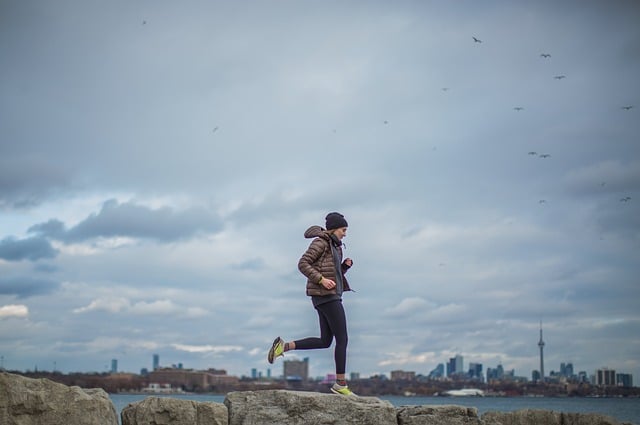
When the weather outside is frightful, it can be tempting to stay bundled up on the couch all winter long. but don't throw your workout gear into storage just yet. A nice cold-weather workout can be quite beneficial! This article will cover the benefits of cold-weather workouts, as well as some safety tips to keep in mind.
Why should you exercise in the cold?
Exercising in the cold forces your body has to work harder to keep you warm, leading to a higher calorie burn and increased strength and endurance. In addition, working out in the cold can improve your mental health by helping to reduce the stress and depression you're more likely to experience in winter.
Finally, exercising outdoors in the winter can give you some much-needed Vitamin D! That boost can help keep the winter blues away, help with calcium absorption, and strengthen your immunity. Keeping up on your exercise regimen can also make it easier to stay in the swing of things when nicer weather appears.
The Benefits of Exercising in the Cold
There can be quite a few good reasons why you should exercise even in cold weather. However, you should always talk with your doctor before starting any new exercise habits.
[Related: 10 Tips to Stick to Your New Year’s Resolutions]
More Efficient Fat BurningBurns
Furthermore, exercising in the cold forces your body to insulate itself better, and muscle helps keep you warm. Muscles also burn more fat. When you do strength exercises in the cold, your muscles will automatically work harder than usual to keep your body warm.
It Boosts Your Mood
Exercising in the cold can help boost your mood by providing a distraction from the winter blues and reducing stress levels. In addition, working out in the cold can help improve your mental health by helping to reduce stress and depression.

Related: Exercise and the Brain
You Get a Dose of Vitamin D
One of the best benefits of exercising in the cold is getting a dose of Vitamin D! Many people get less Vitamin D in the winter from being inside and not getting their typical sun exposure. Exercise can ensure that you continue to get your daily dose.
Getting your adequate Vitamin D is crucial, especially during the winter months. Vitamin D plays a role in keeping your immune system strong and helps regulate mood. So, when the weather gets chilly, fight the urge to stay inside all day.
It Strengthens Your Heart
Cold temperatures also increase the heart's workload, as it works to distribute blood throughout the body. Keep in mind that excessive exercise can exacerbate illness and damage an unhealthy heart that is already under a lot of strain so again, it's important to consult your physician about a new exercise routine.
However, a regular exercise session may help your heart muscle to get even stronger over time, better preparing the body for more rigorous activity in the future. Furthermore, cold temps can make it easier for your heart to work.
Related: Best in Nature Gift Guide
Safety Tips for Exercising in Cold Weather
Even though there are many benefits to exercising in the cold, you should take precautions to stay safe.

Check the Weather Conditions
When you plan to exercise outside in cold weather, it is essential to check the weather conditions first. Make sure that the temperature isn't below freezing or that there is no dangerous weather on the way, such as snow or ice.
Dress Warm with Layers
It is also essential to dress appropriately for the weather. Wear layers of clothing so that you can adjust your temperature as needed. Make sure that your clothes are waterproof and windproof. That way, you can stay warm and comfortable during your exercise time.
Know the Signs of Frostbite and Hypothermia
If you are exercising in cold weather, it is vital to be aware of the signs of frostbite and hypothermia. Frostbite is a medical emergency that occurs when your skin and tissues freeze.
Symptoms of frostbite include:
- Numbness
- Tingling
- Burning
- Reduced sensation
- Skin that feels unusually firm or waxy
- Blisters that form after rewarming
On the other hand, hypothermia is a condition that occurs when your body temperature falls below the normal range.
Symptoms of hypothermia include:
- Shivering
- Drowsiness
- Slurred speech
Both of these can be very dangerous if ignored. If you notice either of these conditions, it is important to seek medical attention right away.
Protect Your Hands, Feet, Head, and Ears
When it comes to cold weather, it is vital to protect your hands, feet, head, and ears. If you don't take precautions to protect these body parts, it could quickly result ine frostbite or hypothermia.
To protect your hands, wear gloves or mittens. Make sure that they are waterproof and windproof. You can also try hand warmers to keep your hands warm. To protect your feet, wear comfortable boots or shoes that are waterproof. You can also try foot warmers to keep your feet warm. To protect your head, wear a hat or hood. And finally, to protect your ears, wear earmuffs or headphones under a hood.

Wear Safety Gear
When exercising in cold weather, it is essential to wear safety gear to protect yourself from the cold—things like hats, gloves, helmets, and more.
Also, it's a great idea to wear reflective equipment whenever possible because, during the colder months, it often becomes darker earlier.
Stay Hydrated
Making sure to stay hydrated is actually even more important in cold weather as our thirst response is diminished by up to 40%.
When you don't drink enough water, you can become dehydrated. Long-term, this has numerous consequences, but severe short-term dehydration can even result in impaired cognitive function.
[Related: 15 Herbs Beneficial to Your Immune System]
Choose a Safe Surface
Choosing a safe surface to exercise on can be critical. Ensuring the path is clear and free of ice or other dangers is important. You should stay away from areas that have standing water because it could be very slippery and dangerous.
How Cold Is Too Cold to Exercise Outside?
As the temperature drops, it becomes increasingly important to take precautions when exercising outside. When the temperature falls below freezing, it is important to dress warmly and avoid exposing your skin to the cold. If the temperature falls below zero, it is essential to stay inside. When the wind chill factor is high, it is best to avoid being outside altogether.
Bottom Line
Exercising in cold weather is challenging and requires some preparation. It's important to dress appropriately, know the signs of frostbite or hypothermia, protect your hands, feet, head, and ears from the elements as well as stay hydrated by drinking water.
Keep yourself in tip-top shape by getting the proper nutrition your body needs. Shop Best in Nature today.
This article is provided for informational purposes only and is not intended to be used as medical advice. If you have immediate concerns about your health and digestion, please seek the help of your physician.





Validate your login
Sign In
Create New Account